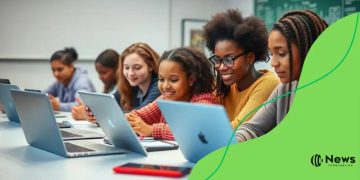AI in classrooms: transforming education for the better

AI in classrooms enhances learning by personalizing education, improving student engagement, and supporting teachers, while also facing challenges like budget constraints and the need for proper training.
AI in classrooms is not just a trend; it’s a game changer for educators and students alike. Have you ever wondered how technology might reshape the way we learn and teach? Let’s dive into this fascinating world.
The role of AI in modern education
AI is playing a crucial role in modern education, making learning more interactive and engaging for students. With innovative tools emerging, educators can harness the power of artificial intelligence to better meet the diverse needs of their classrooms.
Improving Student Engagement
One of the most significant benefits of AI is its ability to enhance student participation. Through adaptive learning platforms, students can receive tailored lessons that cater to their unique learning styles. This personalization fosters a deeper connection with the material.
Furthermore, AI-driven applications often incorporate gamification, which transforms lessons into fun and stimulating experiences. For instance, quizzes and interactive games can motivate students to learn more effectively.
Support for Educators
AI tools don’t just benefit students; they also aid teachers. By automating administrative tasks, such as grading and attendance tracking, educators can spend more time focusing on instruction and student interaction. This shift helps create a more supportive environment for learning.
- Automated feedback allows teachers to address learning gaps promptly.
- Data analytics provides insights into student performance.
- Professional development opportunities can be personalized through AI.
The impact of AI extends beyond just immediate benefits. By integrating these technologies, schools can prepare students for a tech-driven world. As students interact with AI solutions, they not only learn content but also gain essential skills for their future careers.
In conclusion, the role of AI in modern education is significant. Its ability to customize learning experiences and support teachers is shaping the future of education.
Personalized learning experiences with AI
Personalized learning experiences with AI are changing the educational landscape, allowing students to learn at their own pace and style. This approach meets individual needs, making education more effective and enjoyable.
What is Personalized Learning?
Personalized learning tailors education to fit each student’s strengths, weaknesses, and interests. With the help of artificial intelligence, schools can create customized lessons that adapt to how each student learns best. This ensures students are not only engaged but can also excel.
Adaptive Learning Technologies
Many educational applications use AI to provide adaptive learning paths. These tools analyze a student’s performance in real-time and adjust the difficulty of tasks accordingly. For example, if a student consistently excels in math problems, the software will increase the complexity, keeping the student challenged.
- Real-time feedback helps students understand their progress.
- Lessons can be tailored to engage different learning styles.
- Students feel more motivated because the content is relevant to them.
The implementation of AI-driven personalized learning can lead to significant improvements in student performance. Students are more likely to take ownership of their learning when they have resources that address their specific needs.
Furthermore, incorporating such technologies fosters a collaborative environment where students can engage with peers who share similar learning goals. This interaction encourages discussion and deeper understanding of the material, enriching the educational experience.
Enhancing educator capabilities through AI

Enhancing educator capabilities through AI is an exciting development in education. Teachers are now able to utilize technology to improve their teaching methods, streamline their workflows, and foster a more effective learning environment.
Streamlining Administrative Tasks
One key advantage of AI is its ability to automate administrative tasks. Tasks like grading quizzes and tracking attendance can be handled more efficiently, allowing teachers to devote more time to lesson planning and student interaction. This shift helps lessen burnout and increases job satisfaction among educators.
Professional Development Opportunities
AI also enables personalized professional development for educators. Through analyzing data on teaching effectiveness, AI platforms can recommend targeted training programs that meet individual teacher needs. This tailored approach ensures that teachers can enhance their skills in areas where they may require improvement.
- Access to online courses tailored to specific teaching methods.
- Opportunities for collaboration with peers based on shared interests.
- Real-time feedback on teaching practices through analytics.
Moreover, AI tools can assist teachers in creating engaging learning materials. By using data on student interests and performance, these tools help educators design lessons that resonate with their students, making learning more relatable and relevant.
As a result, teachers are better equipped to address diverse classroom needs. With enhanced resources at their fingertips, educators can create dynamic learning environments that motivate and inspire students to achieve their best.
Challenges of implementing AI in classrooms
Implementing AI in classrooms presents several challenges that educators and institutions must navigate. While the potential benefits are vast, understanding these hurdles is crucial for effective integration of technology.
Cost of Technology
One significant challenge is the cost associated with acquiring and maintaining AI technologies. Schools often face budget constraints, making it difficult to invest in the latest tools and software. This financial barrier can limit access for many institutions, especially in underfunded areas.
Training Educators
Another critical factor is the need for comprehensive training for educators. Many teachers may not be familiar with AI tools and may feel overwhelmed by integrating new technologies into their teaching practices. Without proper support and ongoing professional development, the effectiveness of these tools may be diminished.
- Inadequate training can lead to underutilization of resources.
- Teachers may lack the confidence to incorporate AI effectively.
- Continuous support is necessary for successful implementation.
Moreover, there are concerns regarding data privacy and security. With many AI applications relying on student data to function effectively, ensuring that this information is protected is vital. Schools must establish robust policies to safeguard sensitive data and comply with regulations.
Finally, the challenge of changing school culture may arise. Educators, administrators, and parents might resist adopting AI technologies due to fear of change. Building a culture that embraces technology requires transparent communication and a shared vision of enhancing education through AI.
Future trends of AI in educational settings
The future trends of AI in educational settings promise exciting developments that can reshape the landscape of learning. As technology advances, educational institutions are eager to incorporate AI to enhance both teaching and learning experiences.
Increased Personalization
One major trend is the continued push for increased personalization in education. AI tools will analyze student performance data to create tailored learning paths, ensuring that each learner receives the support they need. This personalized approach helps students grasp concepts more effectively and keeps them engaged in their studies.
Integration of Virtual and Augmented Reality
Another trend is the integration of virtual reality (VR) and augmented reality (AR) into learning. AI-driven platforms can create immersive environments that allow students to explore complex subjects in a hands-on manner. For example, a history lesson might take students on a virtual tour of ancient civilizations.
- Students can experience real-world scenarios through simulations.
- AR can overlay information in real time, enhancing learning.
- Interactive experiences can boost student motivation.
Collaboration and communication will also improve with AI technologies. Future tools will enhance interactive platforms, helping students and teachers to collaborate more effectively regardless of their physical locations. This means that group projects can be conducted seamlessly, allowing for greater creativity and innovation.
Finally, as data privacy and security concerns continue to be addressed, schools will likely see a rise in AI’s role in administrative tasks. Smart systems will help institutions manage resources better and analyze trends to inform policy decisions, ultimately leading to more effective educational environments.
FAQ – Frequently Asked Questions about AI in Classrooms
How does AI personalize learning experiences?
AI analyzes student data to create customized learning paths, ensuring that each student learns at their own pace.
What are the main benefits of using AI in education?
AI enhances student engagement, supports teachers in their tasks, and provides data-driven insights for informed decision-making.
What challenges do schools face when implementing AI?
Schools often encounter budget constraints, the need for teacher training, and concerns about data privacy.
How will AI shape the future of education?
AI will continue to enhance personalized learning, integrate new technologies like VR and AR, and improve collaboration among students and teachers.





